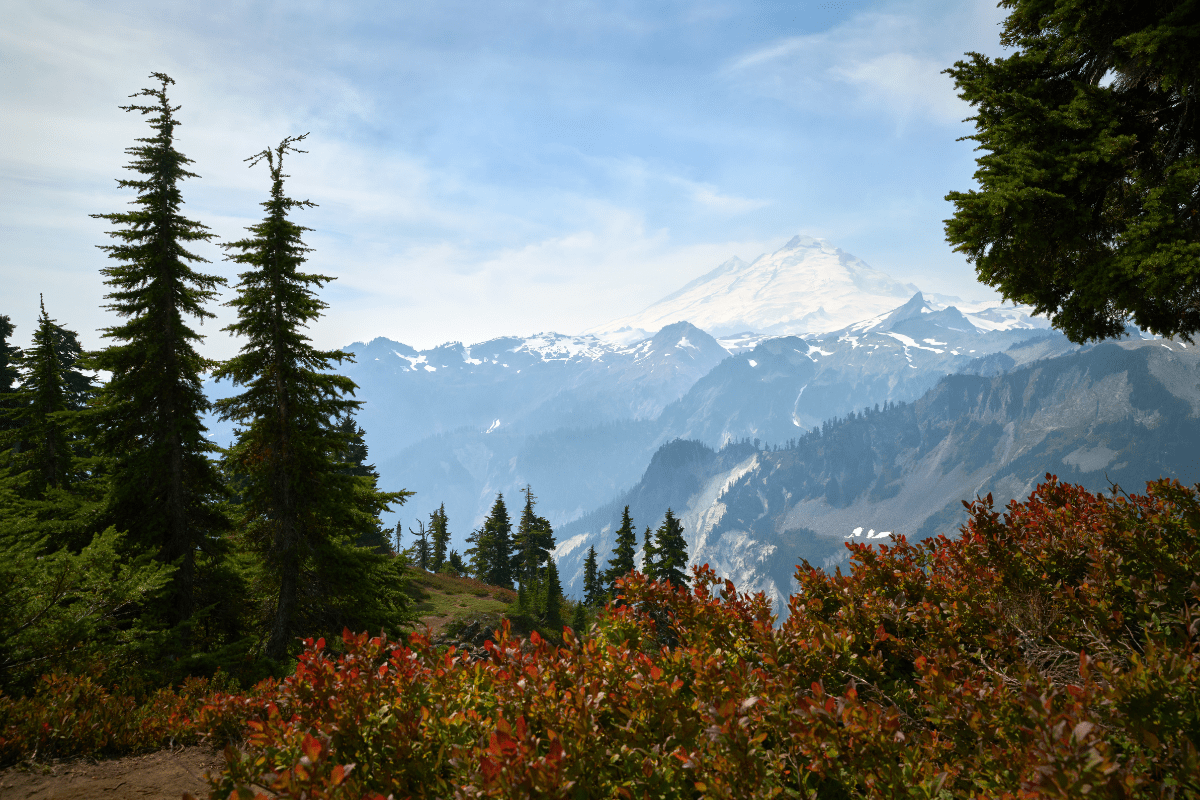Washington State Parks generate $1.6 billion in economic impact annually, which sounds impressive until you realize that works out to just $38 per visitor. That's less than a tank of gas for access to 400+ miles of trails, 70 miles of coastline, and landscapes ranging from sea level to nearly 6,000 feet. Here's how to get the most bang for your Discover Pass buck.
The basics you actually need to know
Let's start with the stuff that'll save you from that awkward moment at the park entrance when you realize you need a pass you don't have.
The Discover Pass costs $10 daily or $30 annually (heads up… it's jumping to $45 on October 1, 2025). This little rectangle of plastic or paper covers day-use parking at all state parks. You can snag one online at washington.goingtocamp.com or at most outdoor retailers. Pro tip: keep it visible on your dashboard, not buried in your glove box under three years of insurance cards.
But wait, there's good news for procrastinators and penny-pinchers! Washington offers 12 free days annually when you don't need a pass. These include New Year's Day (perfect for that resolution hike), MLK Day, and Veterans Day. Mark your calendar and prepare for slightly busier trails on these dates.
Camping fees and the reservation game
Camping fees range from $12 for primitive sites where you'll be best friends with your camp shovel, to $56 for peak-season spots with full hookups where your RV can live its best life. There's an $8 online reservation fee because, well, convenience costs money.
Here's where it gets interesting: you can book campsites up to 9 months in advance for peak season (May 15 through September 15). This means if you want that perfect waterfront spot at Deception Pass for Fourth of July, you better be online in October with your credit card ready. The competition is real, folks.
Good news though… the state recently started allowing same-day camping reservations until 2 PM. So if you're the spontaneous type (or just forgot to plan), you might still score a spot.
How to avoid the masses
Nothing ruins a peaceful nature experience quite like fighting for parking with half of Seattle. The busiest parks see their worst crowds in July and August, particularly on weekends between 10 AM and 4 PM. Deception Pass, Larrabee, and Moran state parks basically turn into outdoor shopping malls during these times.
Smart visitors arrive before 10 AM or after 4 PM, choose weekdays over weekends, or visit during the shoulder seasons of April-May and September-October. The weather might be a bit more… variable… but you'll actually be able to hear the birds instead of car doors slamming.
Hidden gems for crowd haters
If you really want to escape humanity, check out these lesser-known parks that see fewer than 60,000 visitors annually:
- Peshastin Pinnacles (unique rock formations)
- Goldendale Observatory (stargazing programs)
- Leadbetter Point (7 miles of coastline)
- James Island (boat access only)
- Blind Island (3 acres of solitude)
Western Washington's coastal treasures
The western side of the state delivers that classic Pacific Northwest experience… moody weather, dramatic coastlines, and enough green to make your retinas happy.
Deception Pass: The overachiever
Deception Pass State Park is Washington's most visited park with 3.4 million people annually, and honestly, it's easy to see why. The iconic 180-foot bridge connecting Whidbey and Fidalgo Islands provides Instagram gold, while the park's 4,000+ acres offer something for everyone.
The park features 38 miles of trails ranging from the ADA-accessible Sand Dunes Trail (perfect for grandma) to the Goose Rock summit hike (perfect for making grandma worried). Tide pooling at Rosario Beach reveals colorful sea anemones and starfish, assuming you can find a parking spot. Five boat launches and multiple swimming beaches make this a summer favorite for families.
Here's the survival tip: arrive before 11 AM on summer weekends or you'll be circling the parking lot like a vulture. The Civilian Conservation Corps Interpretive Center, housed in a restored 1930s bathhouse, offers a nice rainy-day activity and some historical context about why everything looks so nicely built.
Cape Disappointment: Terribly named, wonderfully dramatic
Despite sounding like somewhere you'd go after a bad breakup, Cape Disappointment State Park delivers serious drama. This 2,023-acre park sits where the Columbia River meets the Pacific Ocean, an area cheerfully nicknamed the "Graveyard of the Pacific."
The park boasts two historic lighthouses that have been keeping ships from becoming submarine lawn ornaments since the 1800s. The Cape Disappointment Lighthouse (1856) holds the title of oldest functioning lighthouse on the West Coast, while its younger sibling North Head Lighthouse (1898) offers tours from May through September.
With 12 miles of trails, you've got options. The quarter-mile paved Bell's Overlook Trail works for all abilities, while the North Head Trail with its 492-foot elevation gain will remind you that you should probably exercise more. History buffs can explore Fort Canby's Civil War-era gun emplacements and WWII bunkers… because nothing says "beach vacation" like military fortifications.
Winter transforms this place into a storm-watcher's paradise. Grab a coffee, bundle up, and watch the Pacific throw its best tantrum. Summer offers eight miles of ocean beach for beachcombing and kite flying, assuming the wind doesn't send your kite to Hawaii.
Fort Worden: Where history meets hipster
This National Historic Landmark in Port Townsend perfectly captures the Pacific Northwest's quirky vibe. The park preserves a complete U.S. Army Coast Artillery Corps base from 1902-1953, featuring 73 historic buildings including Victorian officer quarters you can actually rent for vacation.
The underground batteries are explorable with flashlights (bring your own unless you enjoy stumbling in the dark), and the Puget Sound Coast Artillery Museum satisfies military history nerds. But the real star here is the Underground Cistern… a 2-million-gallon chamber with a 45-second acoustic reverb that makes your shower singing sound positively operatic.
The park offers 2.1 miles of sandy beaches on Admiralty Inlet and 12 miles of trails connecting beaches to historic batteries on Artillery Hill. The on-site Port Townsend Marine Science Center provides educational programs for kids and adults who still get excited about touching sea creatures.
Eastern Washington's geological showstoppers
Cross the Cascades and you'll find a completely different world… one where rain is optional and the landscapes look like they belong on Mars.
Sun Lakes-Dry Falls: Nature's ancient rage quit
Sun Lakes-Dry Falls State Park preserves one of the world's most spectacular geological features… a 400-foot-high, 3.5-mile-wide ancient waterfall that made Niagara Falls look like a backyard water feature. Created by catastrophic Ice Age floods 13,000-15,000 years ago, this internationally recognized site offers a glimpse into Earth's violent past.
Today, instead of torrential waters, you'll find nine lakes perfect for fishing and water sports. The park encompasses 73,640 feet of freshwater shoreline, 15 miles of hiking trails through sage-scented desert, and even a nine-hole golf course for those who like their nature with a side of bogeys.
The dramatic basalt cliffs attract rock climbers, while the minimal light pollution makes this one of the best stargazing spots in Washington State. Just remember: desert sun is no joke. Bring sunscreen, water, and maybe a hat that doesn't make you look like a tourist (good luck with that).
Riverside: Spokane's backyard wilderness
Just minutes from downtown Spokane, Riverside State Park proves you don't need to drive for hours to find adventure. At 12,000 acres, it's massive enough to get properly lost in (but please don't).
The Bowl and Pitcher area features towering basalt formations and a historic 1940 suspension bridge that's way more stable than it looks. The park's trail system is honestly ridiculous:
- 55 miles of hiking trails
- 25 miles of equestrian trails
- 600 acres of ORV terrain
- 40-mile Centennial Trail to Idaho
Rock climbers flock to the basalt cliffs, while the Spokane River provides whitewater kayaking and rafting for those who like their nature with a side of adrenaline. Winter transforms the park into a cross-country skiing and snowshoeing paradise, proving that Spokane knows how to party year-round.
Palouse Falls: Instagram paradise, parking nightmare
Washington's official state waterfall plunges 198 feet into a dramatic basalt canyon carved by the same Ice Age floods that created Dry Falls. The Palouse Indians called it "Aput Aput" (falling water), which is way easier to pronounce than some Washington place names.
Three viewpoints offer different perspectives, with the lower viewpoint providing the most dramatic angle for your inevitable waterfall selfie. Photography enthusiasts lose their minds over the sunset lighting on the canyon walls, creating a golden hour that's actually worth waking up early for (or staying late, depending on your caffeine tolerance).
Fair warning: this place is remote with no cell service and extremely limited parking. Expect waits on weekends, and arrive early unless you enjoy hiking from a mile away. The best flow happens November through April, when the falls are at their most impressive and the crowds are at their thinnest.
Mountain escapes for elevation addicts
Washington's mountain parks offer year-round recreation, from wildflower walks to winter wonderlands.
Mount Spokane: Four seasons of fun
At 5,883 feet, Mount Spokane State Park serves up 100 miles of trails through subalpine meadows and forests. Summer visitors enjoy wildflower displays that would make a florist jealous and huckleberry picking that'll stain your fingers purple for days.
Winter transforms the park into a snow sports paradise with 37 miles of groomed Nordic ski trails, plus snowshoeing and fat-tire biking for those who think regular biking isn't challenging enough. The adjacent ski resort features 1,704 acres with 52 runs, because apparently 51 wasn't enough.
The historic Vista House, built in the 1930s, provides 360-degree views extending to Canada and Idaho on clear days. You can even rent the Quartz Mountain Fire Lookout for a night, living out your forest ranger fantasies while enjoying modern amenities (sorry, no bears included).
Lake Chelan: Where water meets wine
Situated on 50-mile-long Lake Chelan, the third deepest lake in the US at 1,486 feet, this park offers the perfect blend of water recreation and scenic beauty. The crystal-clear waters support every water activity you can think of… swimming, boating, parasailing, and some of the region's best freshwater scuba diving.
The surrounding area encompasses a 24,040-acre wine region, because what's better than a day on the lake? A day on the lake followed by wine tasting. The park serves as a gateway to the remote Stehekin community, accessible only by boat or floatplane, making it perfect for those "I need to disappear for a while" moments.
Popular activities include SUP boarding and fishing, with the Little Bear Trail offering hiking for landlubbers. Summer sees the most visitors, but the annual Polar Bear Splash events make winter visits memorable for those brave enough to take an icy plunge.
Essential planning intel
Before you head out, let's talk about not dying or at least not being miserable in the wilderness.
The 10 essentials (yes, all 10)
Washington State Parks recommends the 10 essentials for every outdoor adventure. This isn't just paranoid parent advice… it's actually useful:
- Navigation tools (map and compass)
- Sun protection (sunglasses and sunscreen)
- Extra layers (weather changes fast)
- Illumination (headlamp or flashlight)
- First aid supplies
- Fire starter
- Repair kit and tools
- Extra food
- Extra water
- Emergency shelter
Regional considerations matter too. Western parks require rain gear year-round because the Pacific Northwest didn't get its reputation by being dry. Eastern desert parks need serious sun protection and extra water because dehydration is not a good look on anyone.
Cell service remains spotty in many parks, particularly remote locations. Download offline maps before you go and always inform someone of your plans. Most developed parks offer restrooms and water, but facilities vary widely, so check individual park pages unless you enjoy surprises.
Seasonal strategies
Spring brings wildflower displays and comfortable hiking weather with fewer crowds. Western Washington's rhododendrons bloom spectacularly, while eastern parks showcase balsamroot and lupine. It's nature's way of apologizing for all that winter rain.
Summer delivers peak activities but also peak crowds. Book early, arrive early, and practice your patience. This is when all 41.4 million annual visitors seem to show up at once.
Fall offers stunning foliage, especially in mountain parks, plus excellent storm watching on the coast. The crowds thin out as kids go back to school, making this arguably the best time to visit.
Winter transforms many mountain parks into snow recreation wonderlands. Mount Spokane and others offer groomed Nordic trails, while coastal parks provide dramatic storm watching. Several parks reduce services in winter, but lower camping fees and minimal crowds reward hardy visitors.
Making it happen
Washington State Parks offer extraordinary diversity across dramatically different landscapes. With proper planning, you can experience these natural treasures while avoiding common frustrations. The key lies in matching parks to your interests and abilities while planning around crowds and weather.
Start with the park nearest you… there's probably one closer than you think. Use those free Discover Pass days to explore without commitment. Book camping well in advance for popular spots, or embrace spontaneity with those new same-day reservations. Don't overlook eastern Washington just because it doesn't match your green-and-rainy Pacific Northwest stereotypes.
With 140+ parks to explore and a handy park finder tool, you'll discover that Washington State Parks offer not just recreation, but a deep connection to the region's natural and cultural heritage. Now stop reading and start exploring… those 41.4 million annual visitors can't all be wrong.





